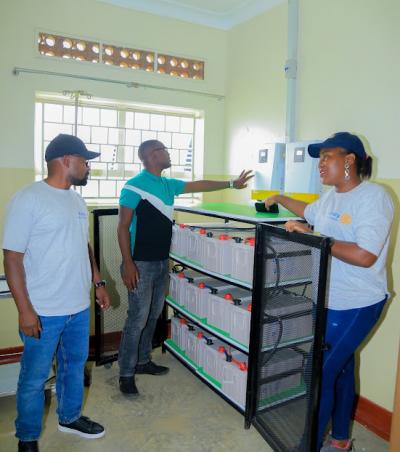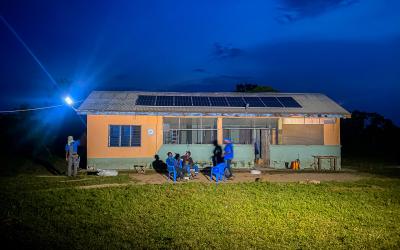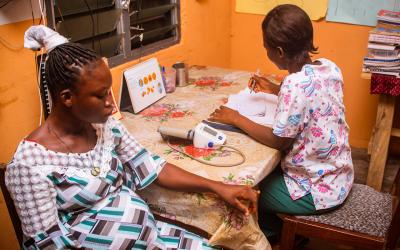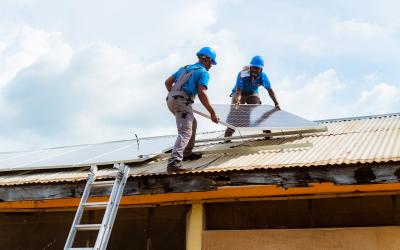Solar energy expands access to health care
A lot of babies are born at the Alokpatsa Community-Based Health Planning and Services compound, a health center in eastern Ghana. And for years, a lot of those babies were born in the dark.
“We didn’t have any power. What we had were lamps and candles,” says Nelson Addy, a former facility team leader at the center in the Oti region. “When the woman delivering had a tear and we wanted to suture, we found it very difficult. We had to strain our eyes with our phone [flashlights] to do the suturing.”
That changed when the Rotary Club of Accra-Spintex, of the Greater Accra region of Ghana, installed a new solar power system at the center. The project included a complete rewiring and, crucially, plenty of lights.
“In the surgical ward, we made sure there would be no need for them to use [phone] lights,” says Nortse Amarteifio, the president of the Accra-Spintex club, whose solar company donated labor and some materials for the $21,000 installation. “We also put in solar streetlights all around the compound and on the street in front of the hospital.”
One of the first mothers to give birth after the installation was so delighted with the upgrades, Addy says, she used “Solar” as the name for one of her children. “It felt like it was all planned by nature for the child to see the first light installed in Alokpatsa,” he says.
Solar solutions
Solar energy previously had powered the Alokpatsa health center, but that system was no longer working. Clinic staff members were excited for the return of a solar system. The Alokpatsa installation is one of numerous Rotary projects using solar power to improve access to health care around the world. In the past dozen years, Rotary clubs have installed solar power systems in health centers in Nepal, Haiti, Pakistan, Mexico, Armenia, India, and many African countries — and there’s much more to do. An estimated 1 billion people in lower-income countries are served by health facilities that lack reliable electricity or have no electricity at all, according to a 2023 report by the World Health Organization. In sub-Saharan Africa, only half of hospitals have reliable electricity. Extreme weather, often connected to climate change, is exacerbating the problem, increasing energy costs and damaging power grids.
“Off-grid health facilities need to have access to clean, reliable energy solutions,” says Luciana Mermet, who works for the United Nations Development Programme as the manager of the Global Fund Partnership and Health Systems Team, HIV and Health Group. “And we’re not talking only about solutions in rural areas. Urban areas can also have unreliable power grids. If you don’t have affordable and sustained energy access, you will have situations where you’re delivering [babies] in candlelight or where you’re unable to refrigerate the health commodities you need to provide care.”

Rotary members in Uganda, including (from left) Joseph Ssuuna, Joseph Ssengooba, and Charlotte Atukunda, led a solar project at a rural health center.
Courtesy of Annie Ninyesiga
Women giving birth in rural areas are among the most affected by such inadequacies, according to the WHO report. It was this problem that galvanized Annie Ninyesiga, president of the Rotary Club of Bwebajja, Uganda, to get a solar system installed at a rural health center in her country. Her club secured a Rotary Foundation global grant in partnership with the Rotary Club of Aarau, Switzerland, to pay for the $76,000 maternal and child health project, which also provided medical equipment, an ambulance, and training for health workers, village health team members, and traditional birth attendants.
“This center serves a very big population in hard-to-reach areas,” Ninyesiga says. “We thought it was important that the people have access to, at least, the basic maternal and child health support.” She adds that solar is superior to the area’s hydroelectric power grid. “The hydroelectric power is not reliable. It’s on and off,” she says. “Sometimes it can’t even charge a mobile phone. Sometimes it provides light but can’t run any equipment.”
Not only do solar panels keep lights shining and equipment functioning, they reduce electrical bills and cut down on the need for generators fueled by expensive — and climate-unfriendly — gasoline. Health facilities then have more funds for patient care. By installing a solar power system at Hospital Bienfaisance in Pignon, Haiti, a Rotary project significantly lowered the hospital’s $4,000 monthly gasoline costs.
Even in areas where there are few or no health centers, solar power can bring health care to people in a very literal way. A few solar panels can enable a doctor to convert a van or trailer into a mobile clinic to serve remote areas.
Revolutionizing vaccine storage
Solar power is also revolutionizing vaccine storage. Many vaccines must be stored at temperatures of 36 to 46 degrees Fahrenheit (2 to 8 degrees Celsius). The oral polio vaccine can be stored at this temperature for six months. In areas with limited or no electricity, or frequent power outages, vaccine refrigerators are often powered by kerosene. They can work only if there’s fuel available, so there may be periods when no vaccines can be stored. Also, this type of refrigerator often provides uneven cooling, spoiling the vaccines inside.
By the numbers
-
675 million
People worldwide without electricity
-
22,000
Square miles of solar panels — about the size of Lake Michigan — that would be needed to power the entire U.S.
-
33%
Share of solar electricity worldwide generated in China
“Sometimes the fridge might not be functioning perfectly — the control is erratic,” says Souleymane Kone, team lead for WHO’s Essential Programme on Immunization. “During the night the temperature might drop down to -1 Celsius [30 Fahrenheit] sometimes, and in the daytime it will go up, exposing the vaccine to excessive heat.”
In 2015 Gavi, the Vaccine Alliance, one of Rotary’s partners in the Global Polio Eradication Initiative, found that up to 90 percent of health facilities in some countries were equipped with old, obsolete, or broken refrigerators. Since then, Gavi, UNICEF (another GPEI partner), and other NGOs have focused on transitioning to solar direct drive refrigerators. First introduced in 2010, these refrigerators are powered directly by the sun without using batteries. The solar energy freezes water or another freezable substance to make an “ice bank” inside the unit that maintains the right temperature after the sun goes down. Costing around $4,000, a fridge can keep vaccines cold for three days or more without the sun shining.
“It is critical for us, especially when looking at increasing the coverage of routine immunizations, that we have a sufficient cold chain storage capacity at all different levels, including the remote areas, including places where there are frequent power fluctuations,” says Anahitta Shirzad, a health specialist with UNICEF’s Immunization Supply Chain program.
“The solar direct drive refrigerators come in very, very handy,” Shirzad says. “They have supported [our goal of] reaching the unreached. We’re looking at the last mile.”
Solar direct drive technology works best with motors such as those used in fans or pumps, while many installations that power whole buildings use solar batteries to store excess energy. At Alokpatsa, the Rotary club solar installation makes it possible to operate a water pump, a sterilizer, and a refrigerator that stores vaccines for two other facilities in the area. It also powers a humbler, but still welcome, piece of equipment: an iron.
“When the lights came, I was able to iron my uniform,” Addy says. “Everyone in the community would now see me as a professional. I felt so happy. I don’t even know how to express this happiness.”
This story originally appeared in the June 2024 issue of Rotary magazine.



